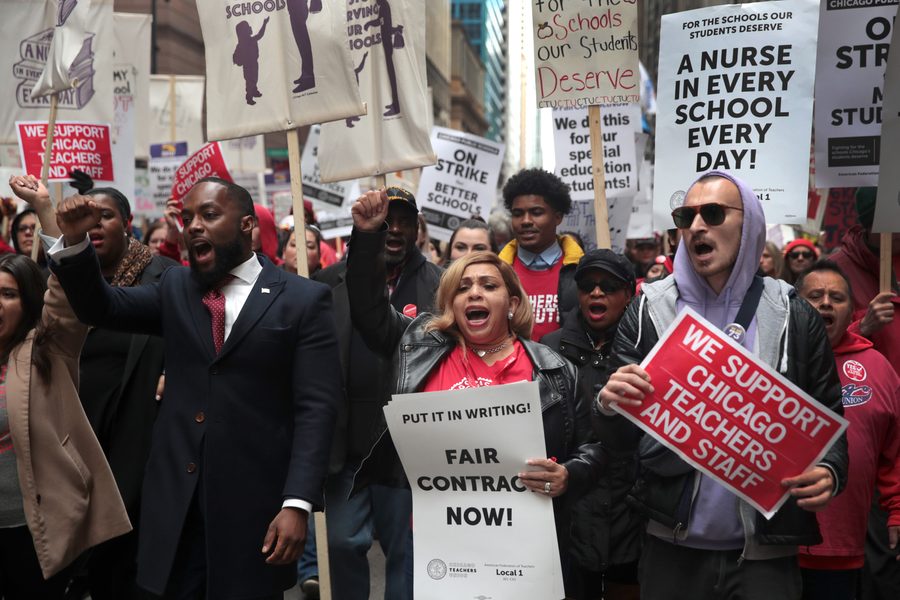
“I solemnly swear that I will never stop fighting for my students.” This hand-made picket sign, one of hundreds at an October 25 Chicago Teachers Union (CTU) and SEIU 73 rally, sums up what makes the teachers’ strike so important. In an approach CTU pioneered during its 2012 strike, the 25,000-strong CTU refuses to draw a firm boundary between justice in the workplace and justice for its students. For the union — under the leadership of the leftwing Caucus of Rank-and-File Educators — affordable housing is a bargaining issue because roughly 17,000 CPS students are experiencing houselessness. And so is the shortage of school nurses, counselors and librarians — along with the corporate and hedge-fund pillaging of a city beset with deep poverty and racial segregation.
Thanks to an Illinois law passed in 1995, the city isn’t legally required to bargain with CTU over issues beyond pay, benefits and hours — a fact that Mayor Lori Lightfoot and local media outlets repeatedly cite. But the idea is that, by building community support and staging disruption, the teachers can expand the boundaries of what’s politically possible and force the city to bend to its social justice demands. As CPS teachers and staff have chanted while marching through Chicago’s streets, “If we don’t get it, shut it down!”
Such efforts to expand what is considered a bargaining issue are often referred to as “bargaining for the common good,” a term popularized by the 2014 creation of an organizing network by the same name. But before that term caught on, the tradition was known as “social justice unionism” — or, as veteran labor organizer and writer Jane McAlevey emphasizes, plain ole’ working-class organizing. “This is not new,” McAlevey tells In These Times. “As long as there have been really good trade unions, there have been fights that blur the lines between workplaces and communities — that address the core needs of rank-and-file members at work and at home. Good organizing has always been good organizing.” As organizer and writer Bill Fletcher Jr. puts it to In These Times, “Social justice unionism involves the transformation of unionism from an instrument of workplace power solely, into a vehicle for worker power more generally.”
Examples from U.S. history show that worker power can be achieved by reaching out across shopfloors, building with community groups, and acting in solidarity with oppressed people in other parts of the world. The Industrial Workers of the World (IWW), founded in Chicago in 1905, called for the creation of one big industrial union, irrespective of shop or craft — or gender or race. This principle was put into practice during the Lawrence, Mass., textile strike of 1912, also known as the Bread and Roses strike. It was started by Everette Mill weavers — immigrant women who were furious over a pay cut after a Massachusetts law shortened the workweek for women. The work stoppage spread to nearly every mill in Lawrence, where textile workers hailing from more than 51 countries staged an industry-wide shutdown during a brutally cold winter — buoyed by the organizing of the IWW. The workers eventually won a 15% wage hike and an increase in overtime pay.
History looks kindly upon such workers who organized across workplaces — and struggles. During World War II, the International Longshore and Warehouse Union (ILWU) opposed the mass internment of Japanese and Japanese-American people, at a time few others were willing to speak out. As labor historian Peter Cole notes in his book Dockworker Power, in 1942, ILWU leader Lou Goldblatt said in sworn testimony before Congress, “This entire episode of hysteria and mob chant against the native-born Japanese will form a dark page of American history.”
Created in 1943 by the Congress of Industrial Organizations, the United Packinghouse Workers of America (UPWA) became a significant force in the Civil Rights and Black Freedom movements. In 1950, the union established an Anti-Discrimination Department aimed at stopping racism in hiring — and segregation in local communities. The union gave robust — and early — support to key racial justice campaigns, including the Montgomery Bus Boycott and the March on Washington. At the 1957 founding meeting of the Southern Christian Leadership Conference, UPWA Vice President Russell Lasley said it was “an extreme honor and privilege to represent UPWA in a conference of leaders who have dedicated their lives to the cause of freedom and the establishment of a society free of racial injustice and second class citizenship.” The union merged with the Amalgamated Meat Cutters in 1968.
The Bay Area’s Local 10 of the ILWU, a union that survived being purged from the CIO during an anti-communist crackdown in 1950, went on in 1984 to refuse to load or unload South African cargo, in solidarity with the anti-apartheid boycott. In 2008, 10,000 ILWU members shut down 29 ports on the West Coast demanding an end to the U.S. wars in Iraq and Afghanistan. In 2015, Local 10 shut down the port of Oakland, Calif., in solidarity with the Black Lives Matter movement.
A matrix of U.S. labor laws seeks to narrow the scope of worker organizing. The 1935 National Labor Relations Act, designed to quell labor unrest, prohibits striking as long as a contract with an employer is in place — a tradeoff for securing bargaining rights. Yet, these bargaining rights are drawn narrowly: The Act also says wages, hours and working conditions are the only mandatory subjects of bargaining for private-sector workers. The Taft-Hartley Act, passed in 1947, imposes further restrictions, including a ban on wildcat, jurisdictional and secondary strikes. And the 1959 Labor Management Disclosure and Reporting Act says secondary strikers can be held liable for damages.
But by building power, workers can transcend these limits: Rank-and-file West Virginia teachers demonstrated as much in 2018, when they went on strike in a state where public-sector strikes are illegal — and then stayed out on strike after union leaders and the governor announced the strike was over. And indeed, Lightfoot eventually agreed to bargain with CTU on social justice issues, thanks to teacher pressure.
The principle that worker power — and not labor law — should determine the shape and scope of labor struggle is especially poignant now, as the world hurtles into an ever-worsening climate crisis that is driven by the capitalist class in industrialized countries but disproportionately harms the poor and working classes, particularly Indigenous communities and people in the Global South. The global climate strikes in September saw 4,500 school walkouts and protests in 150 countries, with most actions led by young people whose lives will almost certainly be shaped by environmental catastrophe. While the movement uses the word “strike,” it’s fallen short of organizing mass-scale work stoppages, although some unions have supported the protests — and some workers have walked off the job. A climate labor-strike, in which workers withdraw their labor, would be the greatest possible social disruption — and therefore the ambitious social justice unionism we need to meet the urgency of the moment.
It’s a difficult road from here to there, but Chicago’s intrepid educators are teaching us that an old tradition is still relevant, and its principles remarkably straightforward. As Nicole Bronson, a striking special education teacher told me as thousands of striking workers gathered at a rally downtown, “This is about giving back to the community that gave to me.”
Sarah Lazare is the editor of Workday Magazine and a contributing editor for In These Times. She tweets at @sarahlazare.








